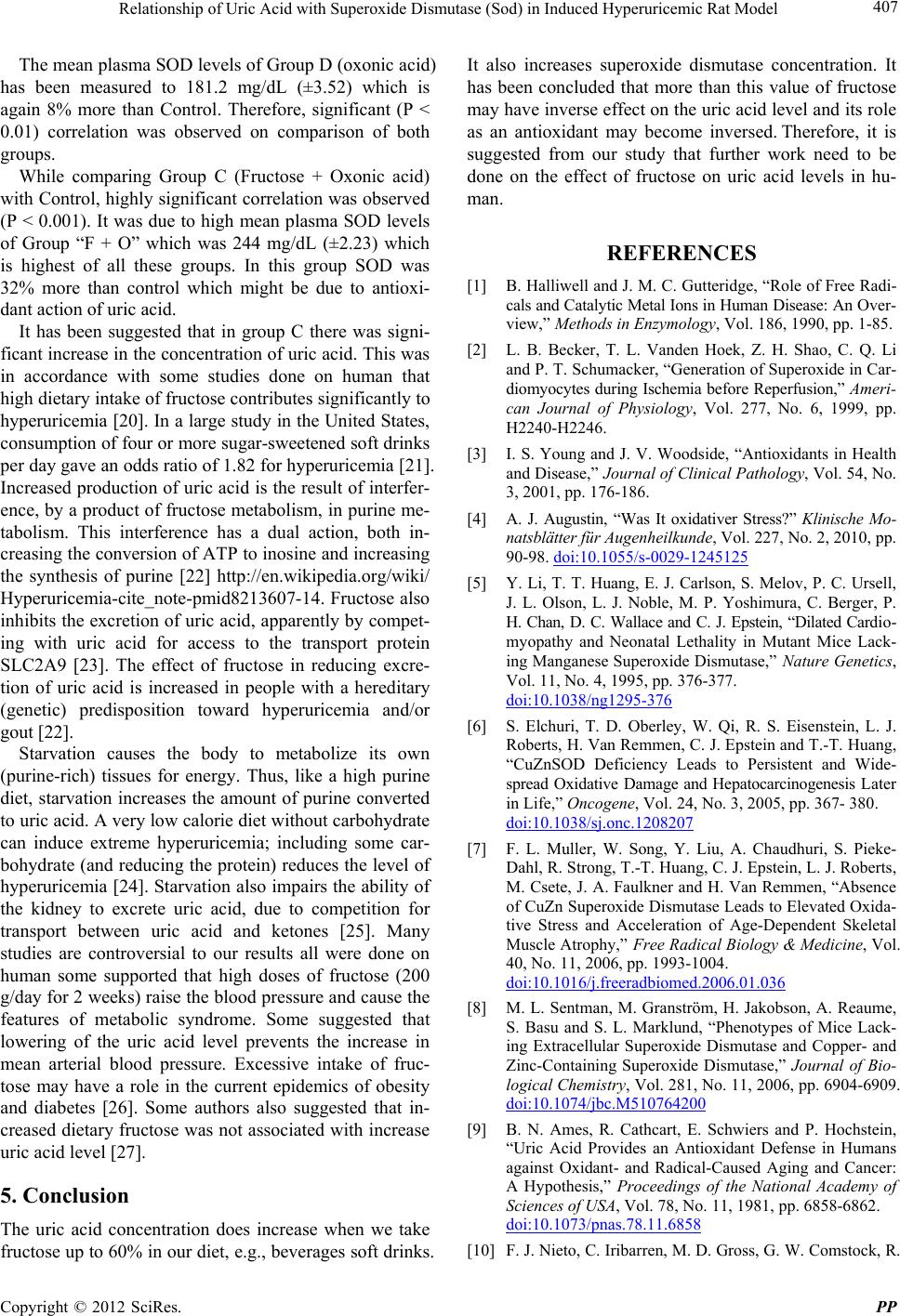
Relationship of Uric Acid with Superoxide Dismutase (Sod) in Induced Hyperuricemic Rat Model 407
The mean plasma SOD levels of Group D (oxonic acid)
has been measured to 181.2 mg/dL (±3.52) which is
again 8% more than Control. Therefore, significant (P <
0.01) correlation was observed on comparison of both
groups.
While comparing Group C (Fructose + Oxonic acid)
with Control, highly significant co rrelation was observed
(P < 0.001). It was due to high mean plasma SOD levels
of Group “F + O” which was 244 mg/dL (±2.23) which
is highest of all these groups. In this group SOD was
32% more than control which might be due to antioxi-
dant action of uric acid.
It has been suggested that in group C there was signi-
ficant increase in the concen tration of uric acid. This was
in accordance with some studies done on human that
high dietary intake of fructose contributes significantly to
hyperuricemia [20]. In a large study in the United States,
consumption of four or more sugar-sweetened soft drinks
per day gave an odds ratio of 1.82 for hyperuricemia [21].
Increased pr oduction of uric acid is th e result of interfer-
ence, by a product of fructose metabolism, in purine me-
tabolism. This interference has a dual action, both in-
creasing the conversion of ATP to inosine and increasing
the synthesis of purine [22] http://en.wikipedia.org/wiki/
Hyperuricemia-cite_note-pmid8213607-14. Fructose also
inhibits the excretion of uric acid, apparently by compet-
ing with uric acid for access to the transport protein
SLC2A9 [23]. The effect of fructose in reducing excre-
tion of uric acid is increased in people with a hereditary
(genetic) predisposition toward hyperuricemia and/or
gout [22] .
Starvation causes the body to metabolize its own
(purine-rich) tissues for energy. Thus, like a high purine
diet, starvation increases the amount of purine converted
to uric acid. A very low calorie diet without carbohydrate
can induce extreme hyperuricemia; including some car-
bohydrate (and redu cing the protein) reduces th e level of
hyperuricemia [24]. Starvation also impairs the ability of
the kidney to excrete uric acid, due to competition for
transport between uric acid and ketones [25]. Many
studies are controversial to our results all were done on
human some supported that high doses of fructose (200
g/day for 2 weeks) raise the blood pressure and cause the
features of metabolic syndrome. Some suggested that
lowering of the uric acid level prevents the increase in
mean arterial blood pressure. Excessive intake of fruc-
tose may have a role in the current epidemics of obesity
and diabetes [26]. Some authors also suggested that in-
creased dietary fructose was not associated with increase
uric acid level [27].
5. Conclusion
The uric acid concentration does increase when we take
fructose up to 60% in our diet, e.g., beverages soft drinks.
It also increases superoxide dismutase concentration. It
has been concluded that more than this value of fructose
may have inverse effect on the uric acid level and its role
as an antioxidant may become inversed. Therefore, it is
suggested from our study that further work need to be
done on the effect of fructose on uric acid levels in hu-
man.
REFERENCES
[1] B. Halliwell and J. M. C. Gutteridge, “Role of Free Radi-
cals and Catalytic Metal Ions in Human Disease: An O ve r-
view,” Methods in Enzymology, Vol. 186, 1990, pp. 1-85.
[2] L. B. Becker, T. L. Vanden Hoek, Z. H. Shao, C. Q. Li
and P. T. Schumacker, “Generation of Superoxide in Car-
diomyocytes during Ischemia before Reperfusion,” Ameri-
can Journal of Physiology, Vol. 277, No. 6, 1999, pp.
H2240-H2246.
[3] I. S. Young and J. V. Woodside, “Antioxidants in Health
and Disease,” Journal of Clinical Pathology, Vol. 54, No.
3, 2001, pp. 176-186.
[4] A. J. Augustin, “Was It oxidativer Stress?” Klinische Mo-
natsblätter für Augenheilkunde, Vol. 227, No. 2, 2010, pp.
90-98. doi:10.1055/s-0029-1245125
[5] Y. Li, T. T. Huang, E. J. Carlson, S. Melov, P. C. Ursell,
J. L. Olson, L. J. Noble, M. P. Yoshimura, C. Berger, P.
H. Chan, D. C. Wallace and C. J. Epstein, “Dilated Card io-
myopathy and Neonatal Lethality in Mutant Mice Lack-
ing Manganese Superoxide Dismutase,” Nature Genetics,
Vol. 11, No. 4, 1995, pp. 376-377.
doi:10.1038/ng1295-376
[6] S. Elchuri, T. D. Oberley, W. Qi, R. S. Eisenstein, L. J.
Roberts, H. Van Remmen, C. J. Epstein and T.-T. Huang,
“CuZnSOD Deficiency Leads to Persistent and Wide-
spread Oxidative Damage and Hepatocarcinogenesis Lat er
in Life,” Oncogene, Vol. 24, No. 3, 2005, pp. 367- 380.
doi:10.1038/sj.onc.1208207
[7] F. L. Muller, W. Song, Y. Liu, A. Chaudhuri, S. Pieke-
Dahl, R. Strong, T.-T. Huang, C. J. Epstein, L. J. Roberts,
M. Csete, J. A. Faulkner and H. Van Remmen, “Absence
of CuZn Superoxide Dismutase Leads to Elevated Oxida-
tive Stress and Acceleration of Age-Dependent Skeletal
Muscle Atrophy,” Free Radical Biology & Medicine, Vol.
40, No. 11, 2006, pp. 1993-1004.
doi:10.1016/j.freeradbiomed.2006.01.036
[8] M. L. Sentman, M. Granström, H. Jakobson, A. Reaume,
S. Basu and S. L. Marklund, “Phenotypes of Mice Lack-
ing Extracellular Superoxide Dismutase and Copper- and
Zinc-Containing Superoxide Dismutase,” Journal of Bio-
logical Chemistry, Vol. 281, No. 11, 2006, pp. 6904-6909.
doi:10.1074/jbc.M510764200
[9] B. N. Ames, R. Cathcart, E. Schwiers and P. Hochstein,
“Uric Acid Provides an Antioxidant Defense in Humans
against Oxidant- and Radical-Caused Aging and Cancer:
A Hypothesis,” Proceedings of the National Academy of
Sciences of USA, Vol. 78, No. 11, 1981, pp. 6858-6862.
doi:10.1073/pnas.78.11.6858
[10] F. J. Nieto, C. Iribarren, M. D. Gross, G. W. Comstock, R.
Copyright © 2012 SciRes. PP